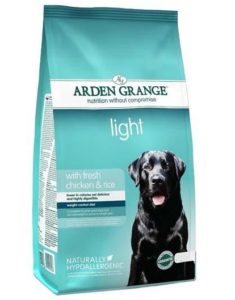“Light” diets are a fallacy. From a nutritional standpoint they don’t offer a dog an optimum way of losing weight. What they do, however, is offer manufacturers the perfect excuse to reduce the cost of production and still charge the same price. Don’t worry, I’ll back this statement up with factual information and explain why.
Arden Grange Light is one such food.
Let’s consider why dogs become overweight in the first place. You may assume it’s from being overfed, and you wouldn’t be wrong if you assume lack of excercise, but the #1 reason for a dog to be overweight in this day and age is high-carbohydrate dry foods formulated from grains such as wheat.
It’s the carbohydrates (sugars) that cause weight gain, not fat. Dogs digest fat (read: animal fat) far more efficiently than we do, using it as a prime source of energy and nutrition. A dog fed a high-protein and animal fat diet will rarely gain weight, and they won’t become bloated like they do on grain-dense diets. That’s a fact blissfully overlooked by pet food manufacturers (because meat ingredients are expensive).
“Light” diets claim to have reduced calories, but by reducing fat (and reducing meat) ensures an increase in carbohydrates, and high-carbohydrate diets cause long term damage and health issues. If you feed a dog a lot of carbs, and they don’t burn it off through exercise, then the carbs turn to sugars.
[placeholder1]
Ok, so enough about “Light” foods, let’s take a look at this one to see if it has merit.
The first ingredient is rice, a cheap carbohydrate filler ingredient. With dogs being much further along the “carnivore” scale than us, you would expect the main ingredient to be meat.
The second ingredient is maize. In fact, the rice and corn amount to 58% of the product according to the ingredients. Given the protein and fat percentages are so low ensures this food is excessive in carbohydrates. I estimate 57.5% which is excessive. It also has to be considered the lacklustre 18% protein will come from maize, which means the amino acids won’t be digested as efficiently as amino acids from meat.
[placeholder2]
Thankfully we find chicken meat meal as the 3rd ingredient, amounting to only 14% of the product, and another token chicken inclusion of 5% which we find after sugar beet pulp. That really isn’t much meat to offer an essentially carnivorous animal. I suppose a plus point of the food is the small amount of whole dried egg and linseed, and it’s a nice gesture to include glucosamine and chondroitin for joint health, but you’ll be far better off feeding your dog a diet richer in meat and meat fats, and you’ll likely see their activity levels increase and the weight drop off.
[placeholder3]
The reason “Light” diets are formulated in this way is because rice and maize are two of the cheapest ingredients in a pet food. Maize is also the cheapest way to inflate the protein without using costly meat ingredients.
Ok, so offering your dog rice and maize instead of starchy grains like wheat and sorghum may help them lose a bit of weight, but it won’t help them achieve optimum health. There are much better alternatives.
[offers]
Rice 31 %, maize, 27%, chicken meat meal (14%), beet pulp, fresh chicken 5%, chicken digest, refined chicken oil, yeast, krill, whole dried egg, whole linseed, minerals, prebiotic FOS, prebiotic MOS, yucca extract, glucosamine, MSM, chondroitin, cranberries, nucleotides.

